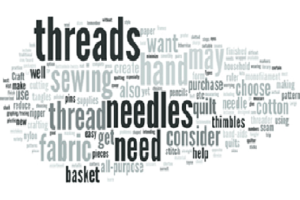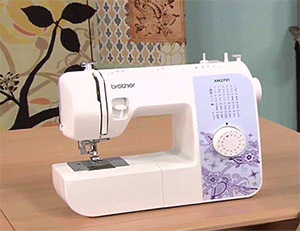
Alteration: Change made to a garment to adjust it so it will fit.
Appliqué: A cutout decoration made of fabric or other material and fastened to a larger piece of material . The edges of the fabric are often secured with satin stitch.
Backstitch: Refers to sewing in reverse, typically to lock in stitches and seams.
Ballpoint needle: These needles are made to sew on knits to avoid picking or damaging the fabric.
Baste: To sew either by hand or machine with the stitch length set for long loose stitches. This will hold the fabric in place until it can be sewn permanently.
Bias: The bias runs along the diagonal of the warp and weft of the fabric and is where there is the most stretch.
Bias tape: Long strips of fabric cut along the bias that is used to bind raw edges of fabric.
Binding: The process of covering or encasing raw edges of fabric with seam binding or bias tape.
Blind Hem: A stitch that allows you to join two pieces of fabric together so that the seam cannot be seen from the right side of the fabric.
Block: To block fabric, stretch it so the warp and weft are at 90% angles.
Bobbin: The small plastic or metal spool that sits in the bobbin case and holds the lower thread of a sewing machine.
Bobbin case: The part of the sewing machine that houses the bobbin.
Casing: A casing is a long tube formed by stitching parallel seams. Elastic or cording can be drawn through the casing.
Clipping: This refers to the small snips made in the fabric up to the stitch line to allow the fabric to curve more easily.
Crosswise grain: This is the weft of the fabric.
Dart: A triangular shape sewn onto a wide piece of fabric to help give it shape so it conforms better to the body.
Easing: This refers to rows of long stitches that allow the fabric to be lightly gathered to make joining two pieces of fabric easier, for example joining a sleeve to the armhole of a shirt.
Facing: These are fabric pieces that are mirror or near mirror image pieces sewn together and then turned back to form a neater edge. This is often found at necklines, collars and cuffs.
Feed dogs: These are the metal teeth that jut up above the needle plate. They help control and move the fabric under the needle as you sew.
Free motion: This refers to quilting or sewing with the feed dogs dropped allowing you to sew in any direction.
Gathering: This is a long running stitch that is used to gather fabric along the stitch line to produce fullness. This is most often seen at the waist, collar and cuffs.
Gusset: This is a piece of fabric sewn into a seam to give more space or freedom of movement.
Hand wheel: This is the wheel on the right side of the sewing machine that allows you to move the needle up and down manually.
Hem: The border of a garment or piece of cloth that is folded and stitched to create a smooth and secure edge.
Inseam: The seam running on the inside of the leg of a pair of slacks or pants.
Interfacing: A layer of fabric or other stiff material that supports and shapes areas that need some reinforcement – cuffs, collars, buttonhole plackets, etc.
Lining: A layer of fabric, sewn inside garments most often made of a thin, slippery fabric. It hides interior seams, gives a professional finish and can make garments more comfortable to wear.
Miter: This is when it is good to cut corners! Mitering trims away the fabric corner to give a smoother, neater 90 degree corner after it is turned.
Nap: The nap refers to the natural direction of fabrics like corduroy and velvet.
Needles: Hand and sewing machine needles come in a wide variety of sizes and shapes. Each is geared toward a certain function.
Needle or Throat plate: The flat metal plate under the needle. Some are made specialized for one or two needles or for the type of sewing being done.
Notching: Is cutting pie shapes from the seam allowance of a curve. This gives space for the seam to lie flat.
Presser foot: There are many different types of presser feet. Some create hems or ruffles, while others facilitate putting in a zipper. Basically, the presser foot puts pressure on the fabric to help it steadily and evenly move under the needle.
Ruching: Gathering fabric along a seam to provide fullness or for decorative purposes.
Ruffle: A strip of fabric that is longer than the fabric it is being attached to. One edge is hemmed and the other edge is gathered along a running stitch to make it full and appear wavy when attached.
Seam: Joining two pieces of fabric together by sewing them along an edge.
Seam Allowance: The amount of fabric between the stitching line and the raw edge of the fabric.
Selvedge: A tightly woven strip along each lengthwise edge of fabric.
Smocking: Smocking is often found on little girls’ dresses. The fabric is folded and stitched together decoratively at regular intervals to create a pattern.
Stitch length selector: This is what allows you to select stitch length on your sewing machine.
Stitch width selector: This allows you to select stitch width.
Take-up lever: The take-up lever is the metal piece that moves up and down as you sew.
Tension (Stitch): Sewing machines have both top and bottom thread tension control. Some have automatic adjustments and some allow tension to be changed to accommodate different fabrics.
Thread guides: Thread guides help control the flow of the thread.
Topstitch: These are machine stitches done on the top or right side of the fabric, typically for decorative reasons to give a garment a more tailored or professional finish.
Walking foot: This is a foot often used in quilting. It has its own set of feed dogs, giving extra control as the fabric is moved under the needle.
Warp: The lengthwise grain of fabric.
Weft: The crosswise grain of fabric.
Zigzag stitch: This is a machine stitch that looks like a continuous “z” and is used to edge fabric to keep it from fraying. When stitches are very close together they form a satin stitch often used to edge appliques.





